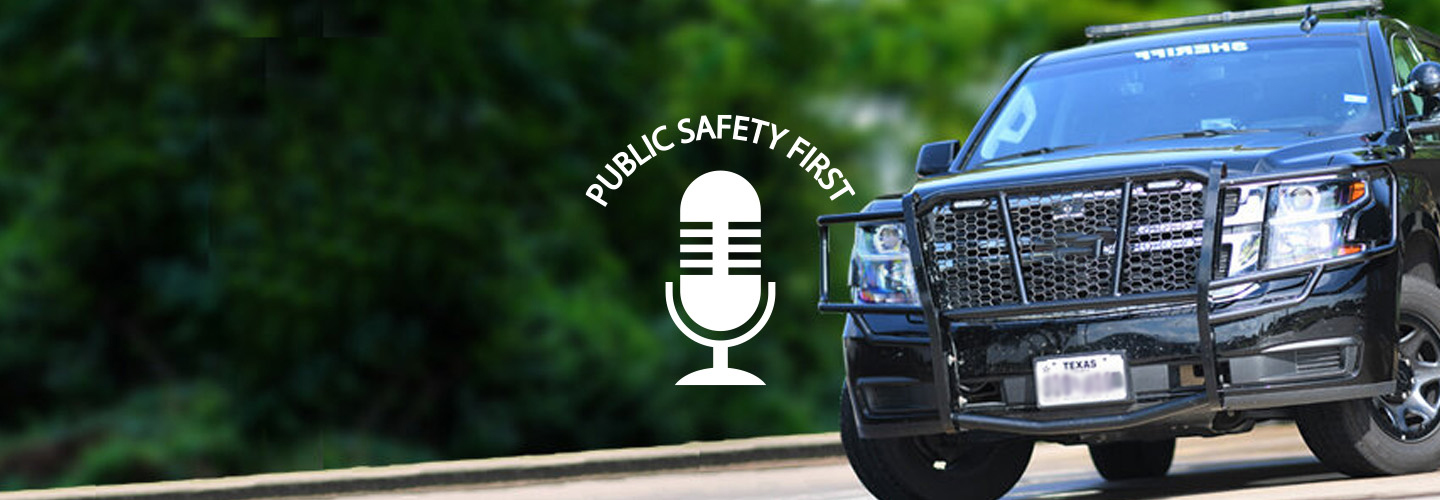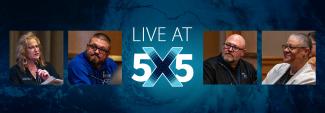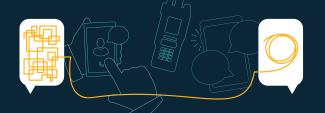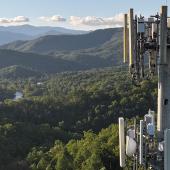Summary
Guest
Tom Randall, FirstNet Authority Senior Public Advisor
Sheriff Richard Kirkpatrick, Kleberg County Sheriff's Office
Transcript
Preview
Episode 74| FirstNet Push-to-Talk Brings Simplicity, Interoperability to Texas Sheriff’s Office
NARRATOR: You're listening to Public Safety First, a podcast to help you learn about the First Responder Network Authority and how you can be part of the future of public safety technology. And now, your host.
Episode 74| FirstNet Push-to-Talk Brings Simplicity, Interoperability to Texas Sheriff’s Office
NARRATOR: You're listening to Public Safety First, a podcast to help you learn about the First Responder Network Authority and how you can be part of the future of public safety technology. And now, your host.
Tom Randall: Welcome to the Public Safety First podcast. I'm Thomas Randall and I serve as a senior public safety advisor for the First Responder Network Authority for Region six states, including Texas. Today I'm here in Kingsville, Texas, and I'm joined by Sheriff Richard Kirkpatrick of the Kleberg County Sheriff's Office. Sheriff, thanks for joining us today on the podcast.
Richard Kirkpatrick: Absolutely. I'm excited to be here.
Tom Randall: That's outstanding. Well, if you don't mind, introduce yourself to the to the folks here and tell us a little bit about Kleberg County and the Kleberg County Sheriff's Office.
Richard Kirkpatrick: My name is Richard Kirkpatrick. I am the elected sheriff in Kleberg County and this is my second term being in office. Here in Kleberg County over the course of time, it has been a, I guess you could call it a transition in terms of communications, in terms of moving things forward from where they were several years back, we've actually come to realize that there's so much out there that makes our jobs so much easier. And over the time we've been able to really integrate with FirstNet and AT&T. We've actually come so far to make our job so much simpler. When I was a young patrol officer back in the day, we just didn't have the technology that we do today and things that are so simple that we take for granted now that just didn't exist back then. And so, it has always been my mission to equip our officers with the best tools that they can have enabling them to be able to communicate. Sometimes in an emergency, you may be left with that very, very, very, very rude awakening when you can't talk to anybody. And when you're in a critical situation, that's where that's where things matter. Really people's lives are on the line when those critical communications need to happen.
Tom Randall: I know Kleberg County is a rural agency. I came from central Texas in a rural agency. And you guys are more South Texas. Talk about where Kleberg County is, population, the terrain and the square miles that you guys’ cover.
Richard Kirkpatrick: Geographically, Kleberg County is a very, very unique place in terms of how the county is laid out. We're situated about 30 minutes south of Corpus Christi on the coast. And because of the unique ranches around us as the infamous King Ranch envelops a good portion of Kleberg County, you have a large area of the county that is mostly unpopulated. And it is owned exclusively by King Ranch. With that said, with the amount of populated areas, we don't really have too many communications issues in the in the populated areas, but it's the unpopulated areas that sometimes that we struggle with. And those areas are the problems where we typically, have occurrences of ranging from everything that you can possibly imagine, with disasters. Because of the size of the sheriff's department, we sometimes are a victim of not being able to be everywhere at the same time. And so, we heavily rely on these things to be able to go out and conduct operations in these areas.
Tom Randall: One of the things that we spoke about is your agency's use of FirstNet and you guys are using a lot of different solutions and taking technology to a whole other realm here in Kleberg County. But there's really a couple of things that caught my attention and things I wanted to focus on with you today and have you share with our audience. And one of those is how you guys were relying on push to talk and that solution and especially how you utilize it in the jail. And so, if you don't mind, tell us a little bit about your experience with FirstNet and the use of push to talk.
Richard Kirkpatrick: Originally when we had traditional LMR push to talk radio, our building structure here is heavily concrete. Because of that, in the areas of the jail, we always struggled even with 800MHz. And, you know, if anybody knows anything about that, you know that when a lot of police agencies transferred from the traditional VHF, that gave us long distance, but it didn't it didn't really solve a lot of building penetration issues. And then as we transitioned over to an 800MHz trunk system, even though there was better building penetration, you know, when it goes down to when you've got a very heavily concrete area and metal around the jail, that's where the communication struggled again. And so, we found ourselves in a unique opportunity. When we started talking about push to talk, it was really a thing of simplicity. We were able to get the building penetration, we were able to talk on the radio. It was kind of a no brainer., It became much more simplified to be able to talk on a secure network. But we found ourselves in a unique situation where we really needed both.
Tom Randall: And when you looked at how push-to-talk was going to help you in the jail and then looking at the interoperability between LMR and LTE over FirstNet, how did you go about that with your with your interop kit?
Richard Kirkpatrick: Initially it was more of a thing where, well, are you going to replace one with the other? And when we started diving into this and realizing that you need both. If you have an officer that's holding a phone, for example, in his hand and he's talking on a push to talk, then we want to enable him with a radio. By the time you start getting all of these devices in, like I got to wear a radio, I got to hold a phone, I got to I got to have this. I got to have that. I've got to have all these tools on my tool belt. We really needed one simple platform that did all of that. And that was why we did what we did because it was able to group all this stuff under one device and do everything. We just wanted to free the officer up from having to have everything on his tool belt to then be able to fuse everything into one platform.
Tom Randall: So, you found it important to augment your radio system and FirstNet was that path?
Richard Kirkpatrick: And just because it was so much easier. I'll give you a case in point so, you know, a jailer is talking back and forth on push to talk in the jail, and then all of a sudden, he needs to make a transport to the courthouse, for example. Well, then he's going to grab up those people, put them in a van and take them to court. Well, now we have a need to be able to talk to a dispatcher. She's got to log that in. So now he's got to put that radio away, grab another radio and tell them, “Hey, I'm going to the courthouse with five inmates”. And then it's this back-and-forth thing again. So, just out of simplicity, that's why we wanted something that we could go and literally switch a switch to another frequency or a channel within the phone and say, “hey, dispatcher I'm in route to the courthouse with, eight inmates”, and the same vice versa coming back to the jail. And then I'm not having to carry multiple platforms on a belt to communicate.
Tom Randall: So, you were talking to me about the devices that you all started with and some of the issues that you had with channel selection and volume and channel being on the screen and you move to a different device that has a channel selector on the top. Talk to me about that.
Richard Kirkpatrick: We first started with a very ruggedized device. It did exactly what we wanted it to do. But the unfortunate part about it was and we found ourselves in this predicament is that sometimes in just everyday life, the device was subject to accidental frequency changes by a button manipulation. And so, the jailers sometimes would end up inadvertently going to another off channel and not really realizing it. And then they're calling on the radio for help. And they didn't realize that they're talking on another channel, if you will. And then the others aren't listening. They can't hear it. They're like, wait a minute, it's just because, the display on the device was small. And really understanding the needs of law enforcement or public safety, is kind of the one of the reasons why when they went to this newer device that had the ability to have a positive selector switch that that not only control the volume, but the other one that manually had to be manipulated on the top of the device, that you know exactly what channel it is. There's no way to bump it or inadvertently allow the unit to, to get on another channel with incidental or accidentally. You know? So, I think in the terms of simplicity, that was a real win-win for us and why we why we did what we did there. And so, it just works out so much better.
Tom Randall: And the fact that it mimics the operation of your LMR radio.
Richard Kirkpatrick: Yes. And again, because the way we've set it up in with the radio Internet gateway, it's literally mirroring the same secondary channel on our 800MHz radio. So, if you switch it over, you literally think that you're on what we call our secondary Channel two, it's literally on Channel two of that radio. So, it mirrors it almost identical. And frankly, you wouldn't really know one way or the other whether you're on it or on an operating on an 800MHz radio or a push to talk. There’s really not too much difference.
Tom Randall: And that's a great point and a good segue into how you then brought the cubic vocality bridge to bring FirstNet push to talk into your network. Talk to us a little bit about what channels you brought in, how you set up the channel plan and what your bridge device was able to ingest as far as LMR and LTE.
Richard Kirkpatrick: Well, the interesting thing about the bridge device was the fact that, it doesn't really matter what you throw at it in terms of being VHF or UHF. The simplicity of the whole ability to jump from one radio to the next was a real eye opener. We had a donor radio to join with the cubic vocality bridge was really again, even in it of itself, was cost effective. When you compare that to the cost of what it takes to do a cubic vocality device, it's a third of that cost. It just made sense because the capability was still there. And it was so much easier for us to do that and be able to have the best of both worlds.
Tom Randall Exactly. And you started off with a couple of channels that you could bridge, but it is working well for you and you're looking to expand on that.
Richard Kirkpatrick: Absolutely. We will ultimately bring another VHF channel on it. The sheriff's department runs all of the emergency services. And so, hopefully some of these other agencies will want to do the same thing. Sometimes third party companies, manage our ambulatory services. And so, a lot of times we don't necessarily give them a full-blown access to our primary radio system. But if they had a push to talk telephone, which most of them do, it makes it so much simpler because we can bring them on. It comes down to simplicity and how we join that stuff and make these interoperability connections that now makes everybody else's life easier. Because sometimes these companies are not within Kleberg County and they're also operating in other counties. When you talk about LMR systems and you go from Nueces County or Kleberg County or Hidalgo or any of these other places in Texas, sometimes they're operating on, their own networks and they're not going to allow us to go and talk on their network because it's privately owned. And if we want to go talk on it, we have to pay about $300 per radio to be programed in. There are occasions when we have emergency operations or operational things that are happening that we need to be able to do that. But simply enough, it's not cost effective. There's no way for me to get in my patrol car and drive an hour from here and go into another county and then be able to talk in their system because it's just not going to happen. And it's not because the sheriff's department is saying, no. It's because you have a private entity that is managing that. But the way they've got it set up now prevents it from happening. And so, we've taken these phones down to other jurisdictions and we supply them with a phone, push to talk phone, and automatically now they're talking to us on our radio. We've solved a major problem in a matter of seconds. I can be anywhere in the state. I can be in New York if I wanted to and still be able to talk on my 800MHz system through that bridge. And so, I think in terms of all of that, I mean, how can you how can you beat it? You know, it just made life so much simpler.
Tom Randall: You’re really looking at solutions that FirstNet is providing to help out with interoperability, with your response partners within Kleberg County, but also with your mutual aid partners that come in.
Richard Kirkpatrick: Corpus Christi, for example, they operate an 800MHz system just the same as we do, but in effort to join those systems together, well, you're talking about a big deal because now we have to literally join the system by fiber line. Well, that's big bucks to do that, you know? I mean, it's a hardline connection between the two systems in an effort to allow them to talk on the radio. So, it's not like, it's not like we can set up a microwave dish and point it to Corpus Christi and get it to work because it will not work like that. And so, making these interoperability connections have been so important for us. We are able to do things so much easier now than we've ever done before.
Tom Randall: So, unlike some of our other conversations with other sheriffs, you've taken this solution on push to talk and FirstNet interoperability one step further than what I've heard before. And that was with your schools.
Richard Kirkpatrick: Oh, yes. When there is a mass shooting, it is pandemonium on all levels. We train for this continuously with active shooter responses. And when I was looking at it from the grand scheme of things we've left out the one thing that we don't talk about, and that is the communications piece. Here in our district, we do have a lot of security guards and if we put a smartphone in their hand with the ability to do push to talk and then in an emergency, they can slide over and now we're all talking, they're providing, onsite information as it's happening right now and we're not having to deal with a delay. Sometimes in the emergency responder business, minutes are like hours, you can't possibly get there fast enough. And so, wouldn't you want that person to feed you on-site information before you got there? Then we're all in a better position to then respond to that threat when seconds matter. And so, again, it comes down to timing. It comes down to knowing what you don't know and being able to have that one little critical piece of information at a second's notice.
Tom Randall: One thing that I wanted to ask also is we talked earlier about some of the fixed cameras that you use for FirstNet. Tell us a little bit about those and then also, is there a plan at some point to maybe access the camera systems within the school to be able to see those either in your command vehicles or even in your patrol deputies MDT?
Richard Kirkpatrick: First and foremost, we have a I guess you could call it a security camera at our boat ramp that is kind of being run by a cradle point router that's connected to FirstNet. Kleberg County has Baffin Bay that is utilized both recreationally by commercial fishermen, sports fishermen. The ugly truth of it is there's thefts that happen there or burglaries of vehicles, you know, people's very expensive boats. So, we do deal with that on some level. But more importantly, we're dealing with, a Border Patrol issue or maybe it's a drug smuggling issue that we're dealing with and being able to identify different watercraft that are going out there at various hours of the night that maybe shouldn't be out there. It really boils down to what can we see at that very moment. On a different note, do we use cameras in one school in our county? In one particular school, yes. We do see the cameras at our school, and we are able to have a connection to that through the smartphone that we can pull up and literally look around.
Tom Randall: Outstanding. Kleberg County is a coastal county. It's a hurricane county.
Richard Kirkpatrick: Oh, gosh. We get slammed with all of that.
Tom Randall: It's a wildfire county and you're a near border County. You're not immediately on the border, but you're considered a border county mainly because of the highway routes that travel through Kleberg County.
Richard Kirkpatrick: It's our proximity to the Gulf of Mexico. And that is one of the reasons why we are deemed a border county. We get it all, and sometimes it's really trying to figure out how do we address certain issues that come up and prioritize those issues. But I think in the grand scheme of things, this has helped us with our manpower issue because, again, eyes and ears in other places are almost as good as the person being there themselves.
Tom Randall: That put you on a path to where you looked at the compact rapid deployables. What was the thought process on how you chose to purchase the compact rapid deployable and what type of use cases are you looking at?
Richard Kirkpatrick: So, when we had our very unfortunate murders that happened down on the beach near Corpus Christi a couple of years ago. We found ourselves in a communications breakdown, because when we were doing the investigation, we were spending hours and hours on the beach there just south of Corpus Christi. The proximity from Corpus Christi to Padre Island National Seashore is literally no more than a few miles. But because there is no houses out there, there are no towers, because there are no towers, there's no communication. And so, when you go down there, no phones work, no radios work, none of that works out there. And so, we found ourselves again in a unique situation where the compact, rapid deployable was that piece that we needed g to be able to connect, to get cellular coverage and be able to establish our own network. It was perfect for what it was because, when you look around the industry and the overall cost to buy a cell site trailer, you're talking massive bucks there. And so now we get to the CRD. And why was that so easy? Because probably under ten minutes, the thing can be literally deployed up and running. It worked well. It does what it's supposed to, you know, and honestly, it's simple. It's easy. There's literally one button you press, and you flip the switches on, and it does its thing.
Tom Randall: Outstanding. Before we wrap things up, anything else that you wanted to add to our conversation today?
Richard Kirkpatrick: We look forward to seeing where things progress because it's always one of those things that you don't know you need something till you know that the infamous thing happens that you say Murphy's Law. Even though we've been through disasters, we've been through emergencies, we know how that plays out. But someone comes along, and they say, “hey, we can do this now that we never did before”. And I always look at that optimistically and I always look forward to seeing what else can we do to make those jobs easier. Giving those first responders the ability to do things that they've never done before in the field. Like I said, I think that probably as time will go forward, that more of tablets in the in the evolution of smart devices will become smarter and the availability of data that's being able to be pushed back and forth because let's face it, you know data itself is a tremendous thing. And how do we get that from point A to point B in the middle of nowhere? And being able to do that in a manner that is timely. We don't want to wait for it ten minutes. We want it now. And that's really where I think progressively in the future where things lay out.
Tom Randall: Well, thank you, Sheriff, for really taking the time to share your experience with us. and speak to us today about your use of FirstNet and some of the solutions that you're looking at. Yeah, it's really been great to have you on the podcast and appreciate it.
Richard Kirkpatrick: Absolutely. Anytime.
NARRATOR: Thanks for listening today. We're excited to have you join our podcast community. Make sure to subscribe on iTunes, SoundCloud, and YouTube. You can learn more about the First Responder Network Authority at FirstNet.gov and learn about FirstNet products and services at FirstNet.com.




















